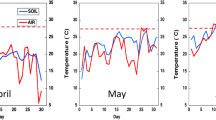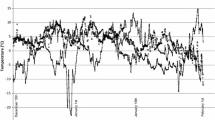Abstract
Sugarcane is a crop which is primarily grown between 30°N and 30°S latitude in tropical environments. Small areas of production in sub-tropical regions exist, and there is an increasing desire to produce the crop in colder environments. Cold-tolerant sugarcane is important both to the sub-tropical sugarcane industries and potential biofuels producers who seek to use sugarcane as a feedstock. Selection for this trait under natural conditions is difficult in sugarcane growing regions because damaging freezes are sporadic. The objective of this study was to identify sugarcane accessions for use in introgression breeding which have above-ground buds that are tolerant to freezing conditions. Above-ground (stalk) buds of 63 Saccharum, and 4 Erianthus accessions were frozen for 6 days at −7 °C, and germinated buds were counted three weeks post-treatment. Accessions which had more bud cold tolerance than the Louisiana commercial cultivar ‘L 97-128’ were MPTH97-213, SES114, Guangxi87-22 and SES234A. Heritability estimates for percent reduction in bud germination and height of the shoots following freeze treatment was 0.47 and 0.49, respectively. Identified clones will be used in future breeding efforts at the United States Department of Agriculture, Agricultural Research Service, Sugarcane Research Unit in Houma, LA, USA.
Similar content being viewed by others
References
Brandes EW (1939) Three generations of cold resistant sugarcane. Sugar Bull 18(4):3–5
Brandes EW (1940) Survival of wild sugarcane buds exposed to below zero (F.) temperatures. Sugar Bull 18(16):3–4
Bransby DI, Allen DJ, Gutterson N, Ikonen G, Richard EP Jr, Rooney W, van Santen E (2010) Engineering advantages, challenges, and status of grass energy crops. In: Mascia PN, Scheffran J, Thomas SR, Widhom JM (eds) Plant Biotechnology for sustainable production of energy and co-products. Springer, Berlin
Breaux RD, Irvine JE (1976) Selection for cold tolerance in sugarcane seedlings from new germplasm. Proc Am Soc Sugar Cane Technol 5:178–181
Brown SJ, Schnell RJ, Power EJ, Douglas SL, Kuhn DN (2007) Analysis of clonal germplasm from five Saccharum species: S. barberi, S. robustum, S. officinarum, S. sinense, and S. spontaneum. A study of inter-and intra-species relationships using microsatellite markers. Genet Resour Crop Evol 54:627–648
Clifton-Brown JC, Lewandowski I (2002) Screening Miscanthus genotypes in field trials to optimize biomass yield and quality in Southern Germany. Eur J Agron 16:97–110
Du YC, Nose A, Wasano A (1999) Thermal characteristics of C4 photosynthetic enzymes from leaves of three sugarcane species differing in cold sensitivity. Plant Cell Physiol 40:298–304
Eggleston G, Legendre B, Tew TL (2004) Indicators of freeze-damaged sugarcane varieties which can predict processing problems. Food Chem 87:119–133
Hale AL, Dufrene EO, Tew TL, Pan Y-B, Viator RP, White PM, Veremis JC, White WH, Cobill R, Richard EP, Rukavina H, Grisham MP (2013a) Registration of ‘Ho 02-113’ Sugarcane. J Plant Regist 7(1):51–57
Hale AL, Viator RP, Veremis JC (2013b) Identification of freeze tolerant Saccharum spontaneum accessions through a pot-based study for use in sugarcane germplasm enhancement for adaptation to temperate climates. Biomass Bioenergy 61:53–57
Hale AL, Viator RP, Eggleston G, Hodnett G, Stelly DM, Boykin D, Miller DK (2016) Estimating broad-sense heritability and investigating the mechanism of genetic transmission of cold tolerance using mannitol as a measure of post-freeze juice degradation in sugarcane and energycane. J Agric Food Chem 64(8):1657–1663
Kandasami PA, Sreenivasan TV, Ramana Rao TC, Palanchami K, Natarajan BV, Alexander KC, Madhusudana Rao M, Mohan Rao D (1983) In Catalouge on Sugarcane Genetic Resources 1. Saccharum Spontaneum L. Sugarcane Breeding Institute. Indian Council of Agriculture Research, Coimbatore
Legendre BL, Tsang WS, Clarke MA (1985) Changes in juice composition of sugarcane as affected by post-freeze deterioration in Louisiana. In Proceedings of the 1984 Sugar Proc Res Conf, New Orleans, LA, pp 92–107
Mary S, Nair NV, Chaturvedi PK, Selvi A (2006) Analysis of genetic diversity among Saccharum spontaneum L. from four geographical regions of India, using molecular markers. Genet Resour Crop Evol 53(6):1221–1231
Ram B, Sreenivasan TV, Sahi BK, Singh N (2001) Introgression of low temperature tolerance and red rot resistance from Erianthus in sugarcane. Euphytica 122:145–153
Roach BT (1971) Nobilization of Sugarcane. Proc Int Soc Sugar Cane Technol 14:206–216
Roka FM, Baucum LE, Rice RW, Alvarez J (2010) Comparing costs and returns for sugarcane production on sand and muck soils of Southern Florida, 2008–2009. J Am Soc Sugar Cane Technol 30:50–66
Saxton AM (1998) A macro for converting mean separation output to letter groupings in Proc Mixed. In Proceedings of 23rd SAS Users Group Intl, SAS Institute, Cary, pp 1243–1246
Tai PYP, Lentini RS (1998) Freeze damage of Florida sugarcane. In: Anderson DL (ed) Sugarcane handbook, Ed. 1. Florida Cooperative Extension Service. University of Florida, Gainesville, p 1
Thomashow MF (1999) Plant cold acclimation: freezing tolerance genes and regulatory mechanisms. Ann Rev Plant Physiol Plant Mol Biol 50:571–599
United States Department of Energy (2008) Ethanol Myths and Facts; Department of Energy; Biomass Program, Washington
Waclawovsky AJ, Sato PM, Lembke CG, Moore PH, Souza GM (2010) Sugarcane for bioenergy production: an assessment of yield and regulation of sucrose content. Plant Biotech J 8:263–276
Acknowledgements
The authors would like to acknowledge their technicians, Halley Burleson, Cory Landry, Lionel Lomax, and Jennifer Chiasson, who helped with the planting, treatments, and general husbandry of the plants and the collection of data for this experiment as well as Kenneth Gravois for help in preparing the manuscript.
Author information
Authors and Affiliations
Corresponding author
Rights and permissions
About this article
Cite this article
Hale, A.L., Viator, R.P., Kimbeng, C. et al. Use of artificially-induced freezing temperatures to identify freeze tolerance in above-ground buds of Saccharum and Erianthus accessions. Euphytica 213, 46 (2017). https://doi.org/10.1007/s10681-016-1826-8
Received:
Accepted:
Published:
DOI: https://doi.org/10.1007/s10681-016-1826-8




